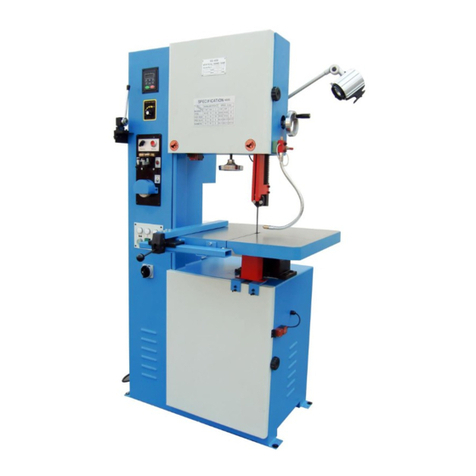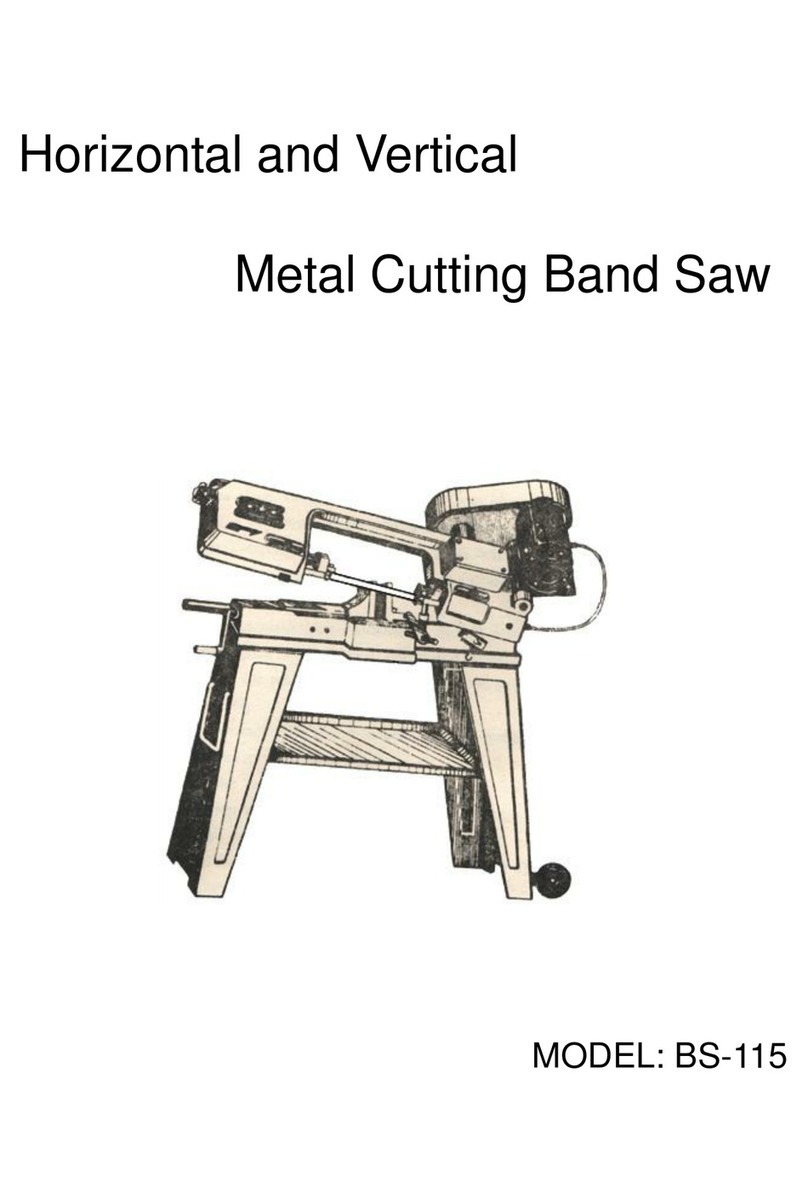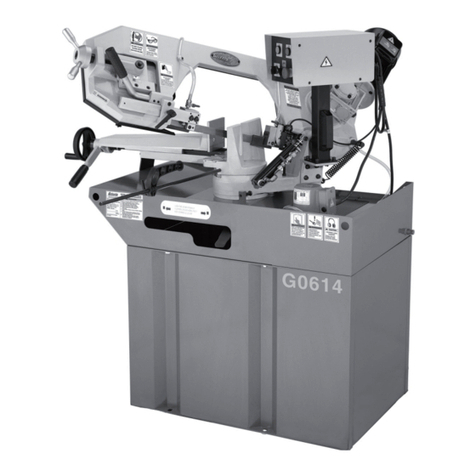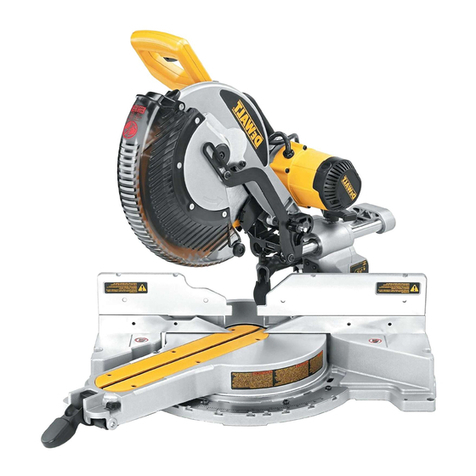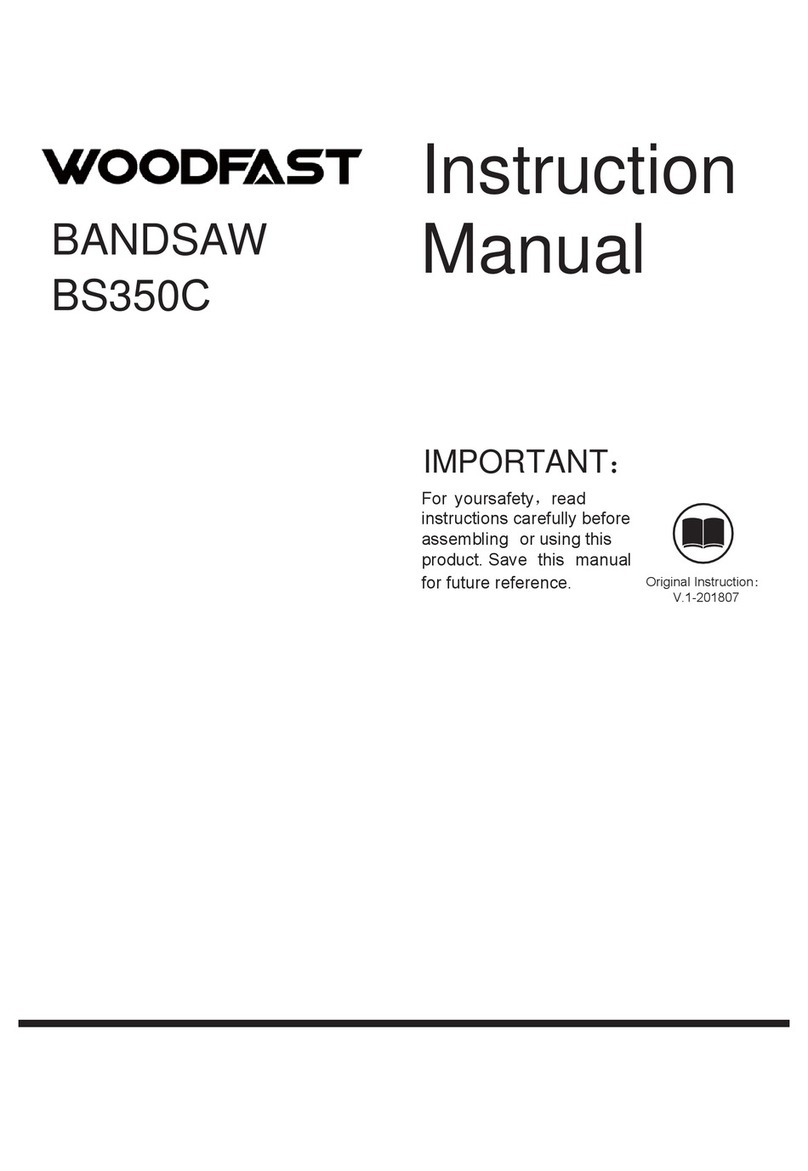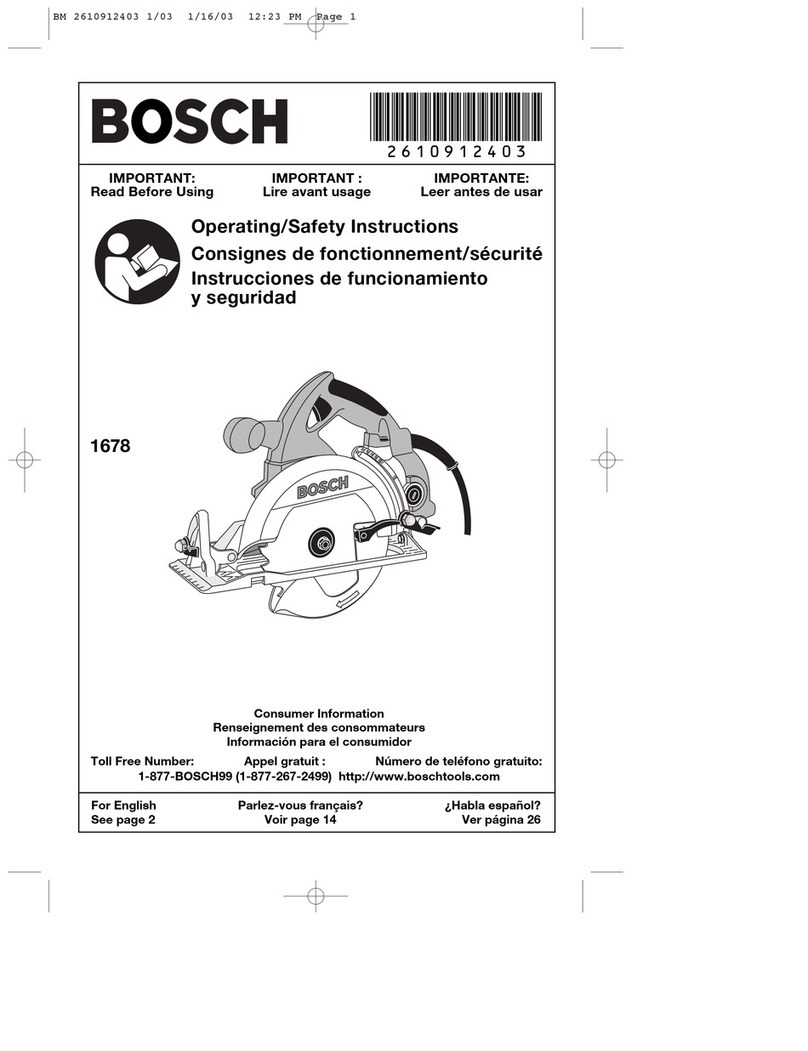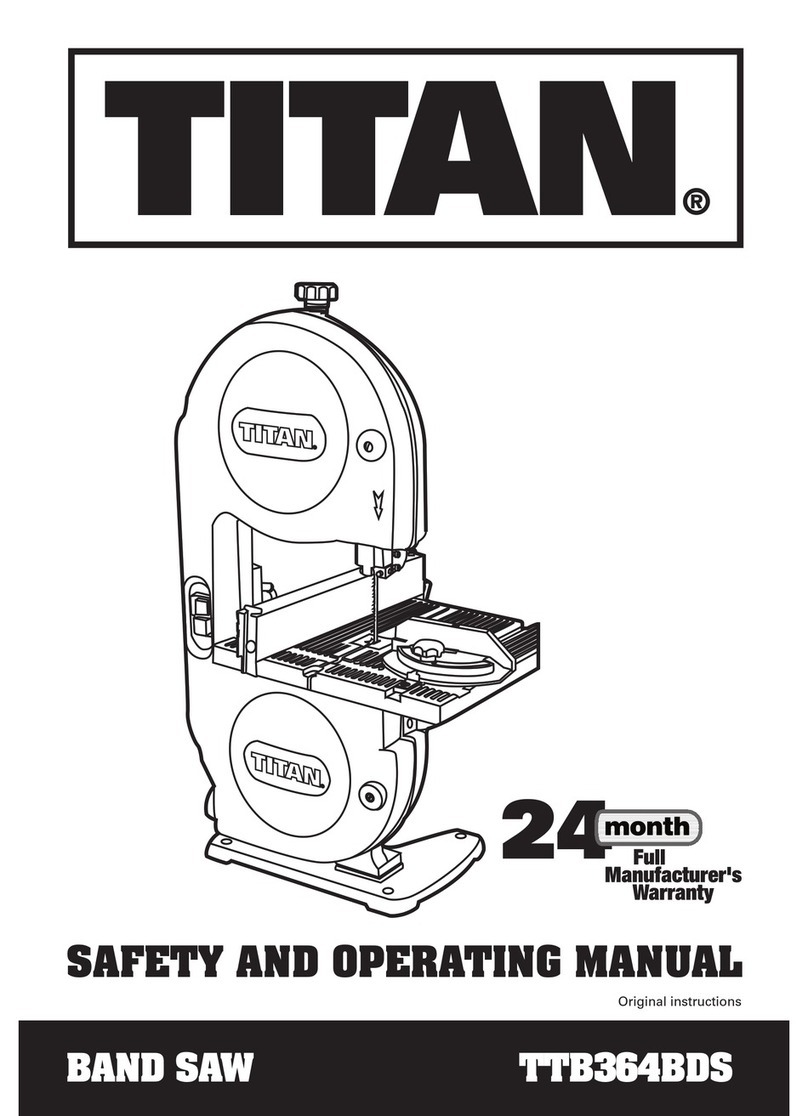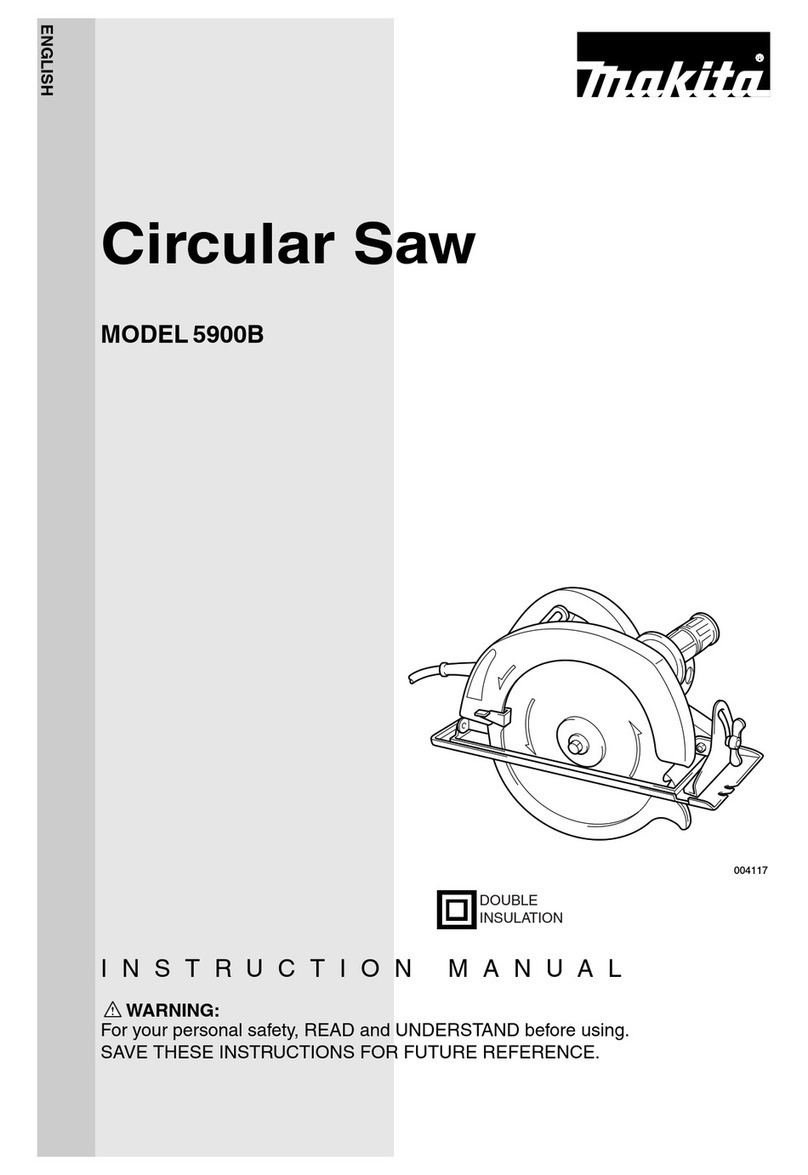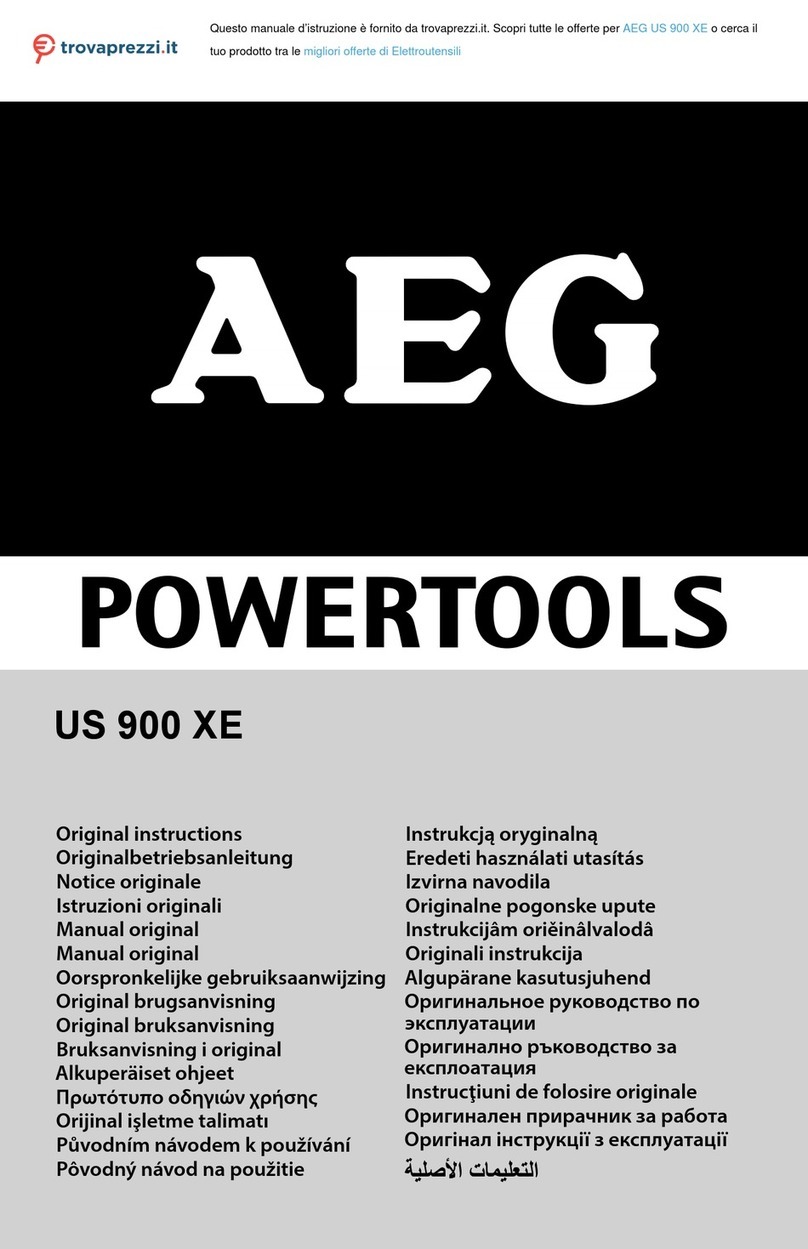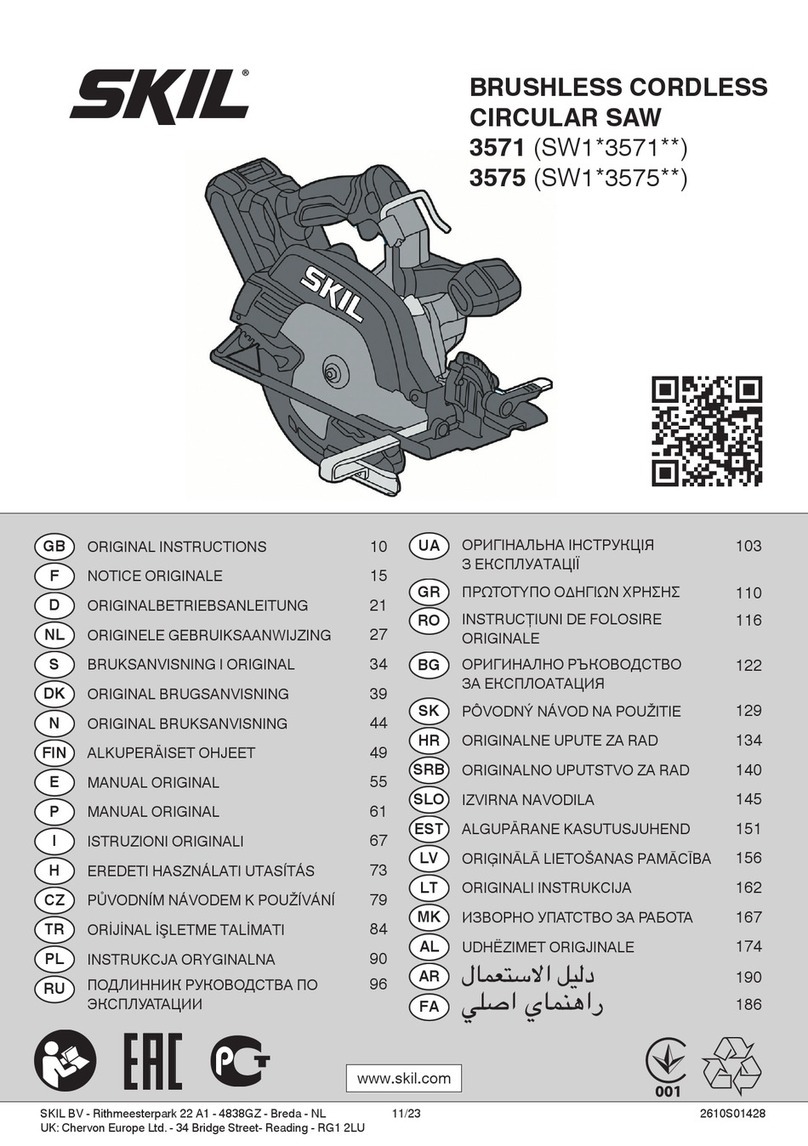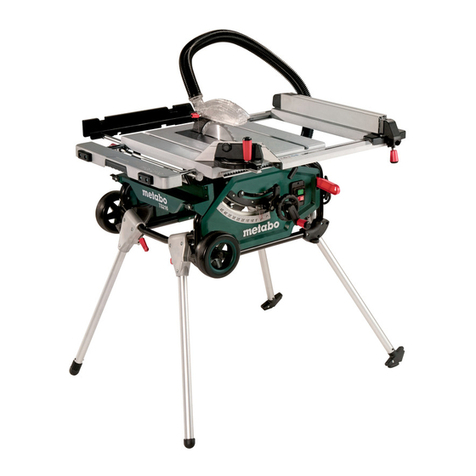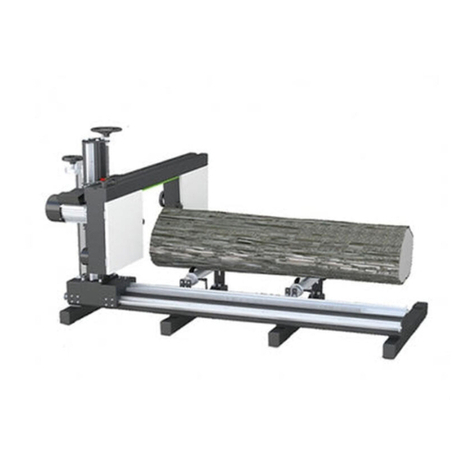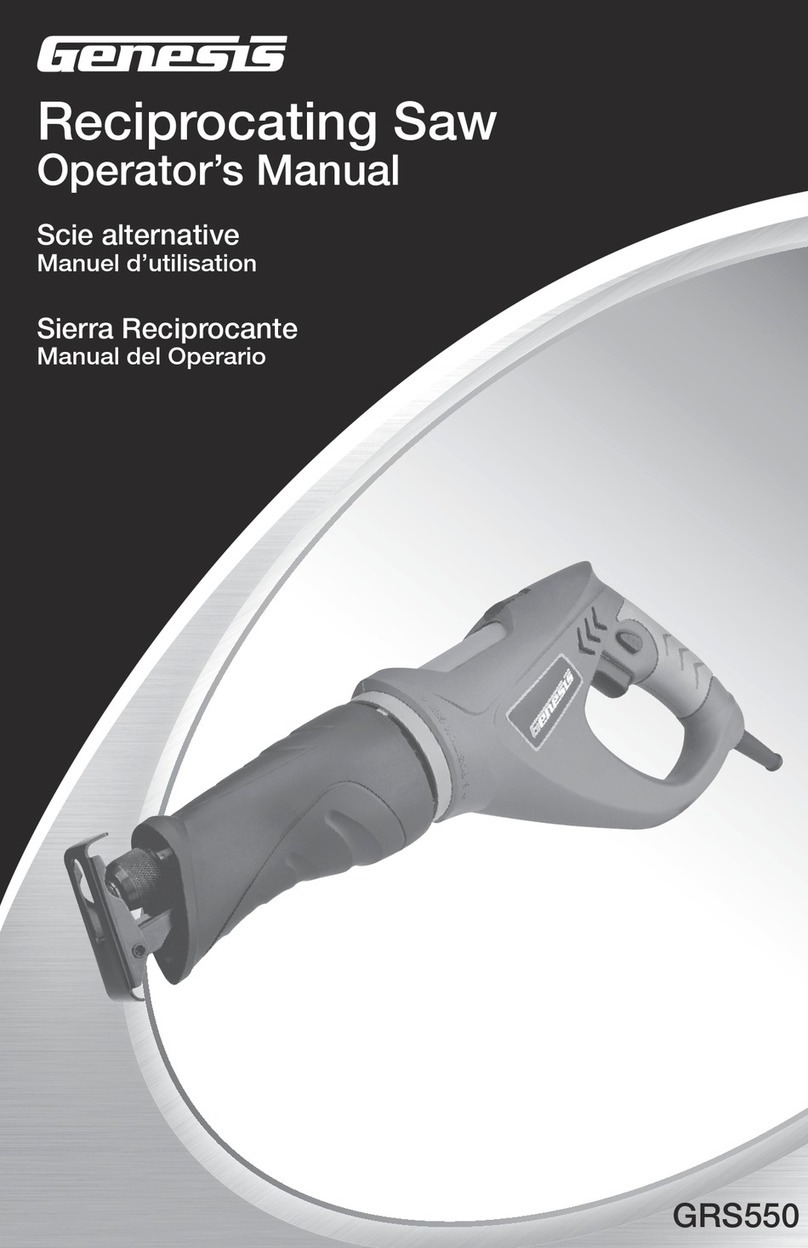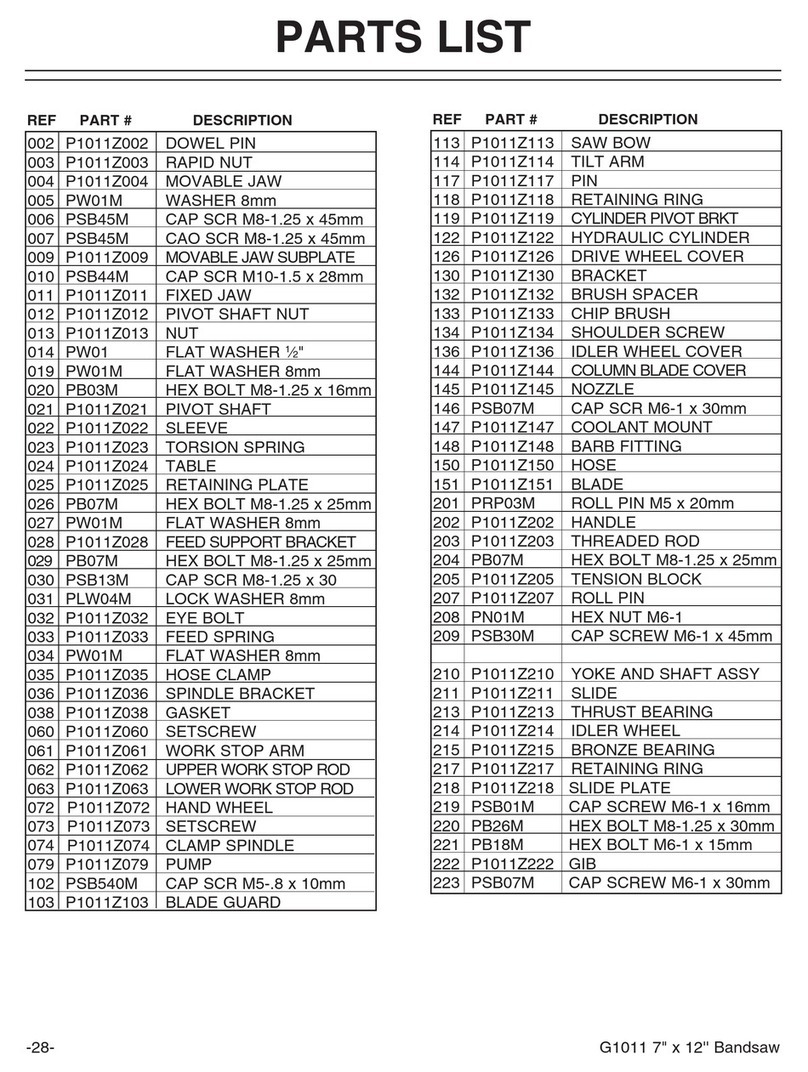STALEX BS-712R User manual

METAL CUTTING BAND SAW
Model: BS-712R
Specifications
Cutting Capacity: 7’’ Round (180mm)
7’’X12’’ Rectangle (180x300mm)
Blade Speed: 86-132-178-260 FPM 60Hz
72-110-148-217 FPM 50Hz
Blade Size: 3/4’’x0.032’’x93’’ (19X0.9X2360mm)
Operation Manual
SAFETY

1. Know your band saw. Read the operator’s Manual carefully. Learn the
operations, applications and limitations as well as the specific potential
hazards peculiar to this band saw.
2. This unit is equipped with a three prong (grounded) plug for your
protection against shock hazards and should be plugged directly into a
property grounded three prong receptacle. Where a two prong wall
receptacle is encountered. It must be replaced with a properly
grounded three prong receptacle in accordance with the National
Electrical Code and Local Codes and Ordinances.
3. Use only 3-wire extension cords that have 3-prong grounding type
plugs.
4. Replace or repair damaged or worn cord immediately.
5. Keep guards in place and in working order.
6. Be especially careful when using band saw in vertical position to keep
fingers and hands out of path of blade.
7. Wear ear protection if exposed to long periods of very noisy shop
operations.
8. Use safety goggles, hardhat and safety shoes. Also use face or dust
mask if cutting operation is dusty.
9. Wear proper apparel. No loose clothing or jewelry to get caught in
moving parts. Do not wear a tie or gloves.
10. Don’t overreach. Keep your proper footing and balance at all times.
11. Secure work. Always use the vise to hold work. Clamp securely. Never
handhold the work with saw in horizontal position.
12. Keep work area clean. Cluttered areas and benches invite accidents.
13. Avoid dangerous environment. Don not use the band saw in damp or
wet location. Keep work area well illuminated.
14. Don’t force tool. It will do the job better and safer at the rate for which it
was designed.
15. Disconnect power cord before adjusting and servicing and before
changing blade.
16. Safety is a combination of operator’s common sense and alertness at
all times when the saw is being used.
17. Never stand on tool. Serious injury could occur if the tool is tipped or if
the cutting tool is accidentally contacted.
18. Check damaged parts. Before further use of the tools, a guard or other
parts that it will operate to assure that it will operate properly
19. And perform its intend function-check for alignment of moving parts;
binding of moving parts, breakage of parts, mounting and any other
conditions that may affect its operation. A guard or other part that is
damaged should be properly repaired or replaced.

20. When moving the saw, ALWAYS have the head lowered to the
horizontal position.
缺电路部分
IMPORTANT:
Coolant pump motor voltage must always be the same as machine motor
voltage.
ASSEMBLY
A 3/4 or 1 HP motor split phase or capacitor start is recommended for best
economical performance. Counter clockwise is required. Note that
rotation can be reversed by following directions given on terminal or
nameplate.
1. Assemble the motor Mounting plate to the head using the long bolt.
Note that the flat side of the plate faces up.
2. Assemble the guard plate to the head using the screw and lock washer
and the carriage bolt. Washer and wing nut are used to secure the
motor mounting plate to the guard plate through the slotted hole in the
guard plate. These components also serve to position and lock the
motor in place or proper speed/belt adjustment.
3. Place the spacer over the long bolt and secure it with the nut.
4. Secure the motor to the motor mounting plate with the four volts and
nuts. Note that the motor shaft is placed through the large opening in
the guard plate and must be parallel with the drive shaft.
5. Assemble the motor pulley, the smaller of the two provided to the
motor shaft. Note the larger diameter must be closest to the motor. Do
not tighten the set screw.
6. Assemble the driven pulley, the larger off the two provided to the
protruding drive shaft. Note the smaller diameter must be closest to the
bearing. Do not tighten the set screw.
7. Place the belt into one of the pulley groove and the other end into the
respective grooves of the second pulley.
8. Line up the belt and both pulleys such that the belt is running parallel in
the pulley grooves.

9. Tighten the set screws of both pulleys in this position.
10. Place the belt into proper pulley combination for proper blade speed.
See material cutting chart.
11. Adjust the position of the motor to obtain approximately 1/2’’
depression in the belt when applying pressure with your thumb.
12. Tighten the head screw holding the motor mounting plate to the guard
plate.
13. Connect the electrical harness to the motor terminal box. The motor
should be protected with a time delay fuse or circuit breaker with a
rated amperage slightly greater than the full-load amperage of the
motor.
INSTALLATION
The saw may be mounted on your own bench or stand. The rear end of
the saw must be mounted flush with the rear of the stand or bench to
permit vertical operation for this band saw. A steel your dealer for this
band saw. This stand has punched holes to effect easy assembly to the
base using eight standard bolts.
OPERATION
WORK SET UP
1. Raise the saw head to vertical position.
2. Open vise to accept the piece to be cut by rotating the wheel at the end
of the base.
3. Place work piece on saw bed. If the piece is long support the end.
4. Clamp work piece securely in vise
WORK STOP ADJUSTMENT
1. Loose the thumb holding the work stop casting to the shaft.
2. Adjust the work stop casting to the desired length position.
3. Rotate the work stop as close to the bottom of the cut as possible.
4. Tighten thumb screw.
5. Do not allow the blade to rest on the work while the motor is shut off.
CONVERTING FOR VERTICAL USE
Nothing, slitting, contour work may be done with the saw in the vertical
position in the following manner:
1. Rotate the head to the vertical position.
2. Assemble a 10’’x10’’ table (an option that may be purchased from your
dealer to the guide bar using the screws provided and the guide bar
knob.)
BLADE SPEEDS
When using your band saw always change the blade speed to best suit
the material being cut. The material cutting shaft given suggested settings
for several materials.
4 SPEED MATERIAL CUTTING CHART

Material
Speed F.P.M. Belt Groove Used
60Hz 50Hz
Motor pulley Saw pulley
Tool, Stainless alloy
Steels, bearing bronze
86 72 Small Largest
Medium to high carbon
132 110 Medium Large
Low to medium carbon
Steels soft brass 178 148 Large Medium
Aluminum plastic 260 217 Largest Small
BLADE DIRECTION OF TRAVEL
Be sure the blade is assembled to the pulleys so that the vertical edge
engages the work piece first.
STARTING SAW
CAUTION: NEVER OPERATE SAW WITHOUT BLADE GUARDS IN
PLACE.
Be sure the blade is not in contact with the work when the motor is started.
Start the motor, allow the saw to come to full speed, and then begin the
cut by left the head down slowly onto the work. DO NOT DROP OR
FORCE. Let the weight of the saw head provide the cutting force. The
saw automatically shuts off at the end of the cut.
BLADE SELECTION
An 8-tooth per inch, general-use blade is furnished with this metal cutting
band saw. Additional blades in 4,6,8 and 10 tooth sizes are available. The
choice of the blade pitch is governed by the thickness of the work to be
cut; the thinner the work piece, the more teeth advised. A minimum of
three teeth should engage the work piece at all times for proper cutting. If
the teeth of the blade are so far apart that they straddle the work, severe
damage to the work piece and to the blade can result.
CHANGING BLADE
Raise saw head to vertical position and open the blade guards. Loosen
tension screw knob sufficiently to allow the saw blade to slip off the
wheels. Install the new blade with teeth slanting toward the motor as
follows:
1. Place the blade in between each of the guide bearings.
2. Slip the blade around the motor pulley (bottom) with the left hand and
hold in position.
3. Hold the blade taut against the motor pulley by pulling the blade
upward with the right hang which is placed at the top of the blade.
4. Remove left hand from bottom pulley and place it at the top aide of the

blade to continue the application on the upward pull on the blade.
5. Remove right hand from blade and adjust the position of the top pulley
to permit left hand to slip the blade around the pulley using the thumb
index and little finger as guides.
6. Adjust the blade tension knob clockwise until it is just right enough so
no blade slippage occurs. Do not tighten excessively.
7. Replace the blade guards.
8. Place 2-3 drops of oil on the blade.
USAGE OF THE QUICK VISE
Your machine is equipped with a quick than action vise jaw, which allows
you to instantly position the movable vise jaw (B). Simply turn hand wheel
(A) counter clockwise 1/2 turn and move the vise jaw (B) to the desired
position. Then tighten the vise jaw (B) against the work piece by turning
hand-wheel clockwise.
QUICK VISE ADJUSTMENT FOR ANGLE CUT
1. Loosen the A.B.C. Screw.
2. Adjust rear vise to the threaded hole position. (E)
3. Set the scale to the desired angle.
4. Adjust the front vise (D) to parallel the rear vise (E).
5. Tighten the A.B.C. Screw.
BLADE GUIDE BEARING ADJUSTMENT
ATTENTION: This is the most important adjustment on your saw. It is
impossible to get satisfactory work form your saw if the blade guides are
not properly adjusted. The blade guide bearing on your metal. Cutting
Band Saw is adjusted and power tested with several test cuts before
leaving the factory to insure proper setting. The need for adjustment
should rarely occur when the saw is used properly. If the guides do get out
of adjustment, it is extremely important to readjust immediately. If
improper adjustment is maintained, the blade will not cut straight, and if
the situation is not corrected it will cause serious blade damage.

Because guide adjustment is a critical factor in the performance of your
saw, it is always best to try a new blade to see if this will correct poor
cutting before beginning to adjust. If a blade becomes dull on one side
sooner than the other, for example, it will begin cutting crooked. A blade
change will correct this problem, the guide adjustment will not. If a new
blade does not correct the problem, check the blade and guides for proper
spacing.
NOTE: There should be from 000 (just touching) 001 clearance between
the blade and guide bearings, to obtain this clearance adjust as follows.
1. The inner guide bearing is fixed and cannot be adjusted.
2. The outer guide bearing is mounted to an eccentric bushing and can
be adjusted.
3. Loose the nut while holding the bolt with an Allen wrench.
4. Position the eccentric by turning the bolt to the desired position of
clearance.
5. Tighten the nut.
6. Adjust the second blade guide bearing in the same manner.
BLADE TRACK ADJUSTMENT
1. Open the blade guard.
2. Remove the blade guide assemblies (top and bottom)
3. Loosen the hex head screw in the tilting mechanism to a point where it
is loose but snug.
4. With the machine running, adjust both the set screw and blade tension
knob simultaneously to keep constant tension on the blade. The set
screw and blade tension knob are always tuned in opposite directions,
when one is turned clockwise the other is turned counterclockwise.
The blade is tracking properly when the back side just touches the
shoulder of pulley or a slight gap appears near the center line of the
pulley. Care should be taken not to over tighten the saw blade since
this will give a false adjustment and limit life of the blade.
5. Tighten the hex head screw in tilting mechanism IMPORTANT:
Sometimes for trying to make this critical adjustment it is possible to
cause the basic setting to be misaligned. Should this occur, proceeds
as follows:
a. Loosen the set screw and back it out as far as it can go and still
remain in the threaded hold.
b. Turn the hex head screw clockwise until it stops (do not
tighten).
c. Turn the set screw clockwise until its bottoms, then continue for
half a turn and check the tracking by turning on the machine.
d. If further adjustment is required, go back to step 4.
6. Turn off power to the machine.
7. Replace the blade guide assemblies – it may be necessary to loosen
the blade tension lightly.
8. Adjust the vertical position of blade guide bearing assemblies so that
the back side of the blade just touches the ball bearings.

9. Make a final run to check tracking. If required, touch up adjustment
(See stop 4)
10. Replace the blade guards.
MAINTENANCE
CAUTION: MAKE CERTAIN THAT THE UNIT IS DISCONNECTED FROM THE
POWER SOURCE BEFORE ATTEMTING TO SERVICE OR REMOVE ANY
COMPONENT!
LUBRICATION
Lubricate the following components using SAE-30 oil as noted.
1. Ball bearing none.
2. Driven pulley bearing 6-8 drops a week.
3. Vise lead screw as needed.
4. The drive gears run in an oil bath and will not require a lubricant
change more often than once a year, unless the lubricant is
accidentally contaminated or a leak occurs because of improper
replacement of the gear box cover. During the first few days of
operation, the worm gear drive will run hot. Unless the temperature
exceeds 200F, there is no cause for alarm.
The following lubricants may be used for the gear box:
Atlantic Refinery Co., Mogul Cyl. Oil
Cities Service Optimums No.6
Gulf Refinery Co Medium Gear Oil
Pure Oil co. Park Clipper
SHIPPING CONTAINER CONTENTS
Saw 1
Wheel axis 2
Wheel 4
Split pin 4
Material stop bar 1
Material stop 1
Belt cover 1
Vertical cutting plate 1
Tools required for assembly
#2 cross point screwdriver
Pliers
Unpacking and clean-up
1. Finish uncrating the saw. Inspect it for shipping damage. If any
damage has occurred, contact your distributor.
2. Unbolt the saw from the skid and place it on a level surface.
3. Clean rust protected surfaces with kerosene, diesel oil, oil a mild
solvent. Do not use cellulose based solvents such as paint thinner or
lacquer thinner. These will damage painted surfaces.
Assembly
1. Place blocking under the ends of the saw base to allow wheel

installation. Caution: Make sure saw is steady while temporarily
supported.
2. Slide wheel axles through holes in base.
3. Slide wheel onto axles and fasten with pins. Bend pins to hold in place.
4. Slide material stop bar (A, Fig. 1) into base and secure by tightening
bolt (B). Slide material stop (C) onto bar and tighten blot (D).
5. Slide belt cover over pulley assemblies and fasten with screws and
washers (A, Fig. 2).
6. Close belt cover and secure with lock knob (B).
7. Remove transportation strap and keep for later use should the saw be
moved any distance.
Vertical cutting plate assembly
Note: these steps are only necessary if
using the band saw in the vertical mode.
! Warning
Disconnect band saw from the power source before
making any repairs or adjustments!
Failure to comply may cause serious injury!
1. Disconnect the band saw from the power source.
2. Raise the arm to the vertical position and lock in
place by turning the hydraulic cylinder valve to
the off position.
3. Remove two screws (A, Fig. 3) and the
deflector plate (B).
4. Guide blade through slot in table and fasten
with two screws. See Fig. 4.
Coolant tank preparation
Use of a water-soluble coolant will increase cutting
efficiency and prolong blade life. Do not use black
cutting oil as a substitute. Change cutting oil often
and follow manufacturers instructions as to its uses and precautions.
1. Disconnect machine from the power source.
2. Remove coolant return hose from tank cover.
3. Slide tank out of saw base and carefully remove lid containing coolant pump.
4. Fill tank to approximately 80% of capacity.
5. Place lid back onto tank and place tank assembly back into base.
6. Replace return hose back into hole in tank lid.
Electric Box (For UE-712A)
A. Part No. A-Emergency stop switch (EMS).
It stops all electric motors including coolant pump.
B. Part No. B-Start switch.
C. Part No. C-Stop switch.
There is a relay inside the electric box.
When machine is overloaded and the
current is to high. This relay will switch
off automatically as protections. It cuts

off all electrics and machine stops.
Open the electric box and find this switch
in white button. Please reset this white
button to function the electrics again.
If this machine gets overloaded too often,
try to adjust the really-make the setting of
current higher.
Adjusting blade square to table
1. Disconnect machine from the power source.
2. Place machinist’s square on table next to blade
as pictured in Fig. 13.
3. Check to see blade makes contact with square
along the entire width of the blade.
4. If adjustment is necessary, loosen bolts (A Fig. 13)
and rotate blade guide assemblies slightly in the
same direction until blade makes contact with the
square along it’s entire width.
5. Tighten bolts (A).
6. Connect machine to the power source.
Note: If adjustment to square blade to table is
necessary, be sure to check blade adjustments again.
Adjusting blade square to vise
1. Disconnect machine from the power source.
2. Place a machinist’s square as pictured in figure 14. Square should lie along entire
length of vise and blade without a gap.
3. If adjustment is necessary, loosen bolts holding vice and adjust vise so that square lines
up properly. Tighten bolts.
4. Connect machine to the power source.
Adjusting blade guides
1. Disconnect machine from the power source.
2. Loosen knob (A. Fig. 8) and bolt (B).
Slide blade guide assemblies as close as
possible to the material without interesting
with the cut.
3. Tighten knob (A) and bolt (B) and connect
4. machine to the power source.
Vise adjustment
! Warning
Do not make any adjustments or load/unload
material from vise while machine is running!
Failure to comply may cause serious injury!
To set the vise for 0 to 45 degree cutting:
1. Remove bolt assemblies (C. Fig. 9)
2. Position vise and re-install as

pictured in Fig. 10. Pay particular
attention to bolt hole location.
3. Set vise to desired angle, re-install
bolts, and lighten nut and bolt
assemblies.
4. Adjust movable vise parallel to fixed
vise by loosening blot (A, Fig. 10),
adjusting to parallel and tightening bolt.
To set vise for maximum width of stock cutting:
1. Remove nut and bolt assemblies.
2. Position vise and re-install bolt assemblies as pictured in Fig 9.
TROUBLE SHOOTING CHART
Symptom Possible Cause (s) Corrective Action
Excessive Blade
Breakage
1. Material loose in vise
2. Incorrect speed or feed
3. Blade teeth spacing too
large
4. Material too coarse
5. Incorrect blade tension
6. Teeth in contact with
material before saw is
started
7. Blade rubs on wheel
flange
8.
Misaligned guide
bearings
9. Cracking at weld
1. Clamp work securely
2. Adjust speed or feed
3. Replace with a small teeth
spacing blade
4. Use a blade of slow speed
and small teeth spacing
5. Adjust where blade just
does not slip on wheel
6. Place blade in correct with
work after motor is started
7. Adjust wheel alignment
8. Adjust guide bearings
9. Weld again, note the weld
skill
Premature Blade
Dulling
1. Teeth too coarse
2. Too much speed
3. Inadequate feed pressure
4. Hard spots or scale on
material
5. Work hardening of
material
6. Blade twist
7. Insufficient blade
1. Use finer teeth
2. Decrease speed
3. Decrease spring tension
on side of saw
4. Reduce speed, increase
feed pressure
5. Increase feed pressure by
reducing spring tension
6. Replace with a new blade,
and adjust blade tension
7. Tighten blade tension
adjustable knob

Unusual Wear on
Side/Back of Blade
1. Blade guides worn
2. Blade guide bearings not
adjusted properly
3. Blade guide bearing
bracket is loose
1. Replace
2. Adjust as per operators
manual
3. Tighten
Symptom Possible Cause (s) Corrective Action
Teeth Ripping from
Blade
1. Tooth too coarse for work
2. Too heavy pressure, too
slow speed
3. Vibrating work piece
4. Gullets loading
1. Use finer tooth blade
2. Decrease pressure,
increase speed
3. Clamp work piece
securely
4. Use coarse tooth blade or
brush to remove chips
Motor running too hot
1. Blade tension too high
2. Drive belt tension too high
3. Gears need lubrication
4. Cut is binding blade
5. Gears aligned improperly
1. Reduce tension on blade
2. Reduce tension on drive
belt
3. Check oil bath
4. Decrease feed and speed
5. Adjust gears so that worm
is in center of gear
Bad Cuts
1. Feed pressure too great
2. Guide bearing not
adjusted properly
3. Inadequate blade tension
4. Dull blade
5. Speed incorrect
6. Blade guide spaced out
too much
7. Blade guide assembly
loose
8. Blade truck too far away
from wheel flanges
1. Reduce pressure by
increasing spring tension
on side of saw
2. Adjust guide bearing, the
clearance can not be
greater than 0.001mm
3. Increase blade tension by
adjust blade tension
4. Replace blade
5. Adjust speed
6. Adjust guides space
7. Tighten
8. Re-track blade according
to operating instructions
Bad Cuts
(Rough)
1. Too much speed or feed
2. Blade is too coarse
3. Blade tension loose
1. Decrease speed or feed
2. Replace with finer blade
3. Adjust blade tension
Blade is twisting 1. Cut is binding blade
2. Too much blade tension
1. Decrease feed pressure
2. Decrease blade tension

PARTS LIST
Part
No. Description Qty. Part
No. Description Qty.
77
142
143
144
145
146
147
148
149
150
151
118
119
119-1
119-2
120
121
122
123
123-1
124
125
126
127
128
129
130
130-1
131
132
133
134
135
136
136-1
137
137-1
138
139
140
141
188
189
190
191
192
193
194
195
196
197
198
199
200
201
Bearing bushing (front)
Vertical cutting plate
Adjustable blade seat
Hex. Hd. screw
Top support
Spring washer
Nut
Round hd. screw
Washer
Brush holder
Hex. Hd. screw
Ball bearing
Hex. Hd. screw
Spring washer
Washer
Oil seal
Bear box
Sping washer
Hex. Hd. screw
Adj. Screw
Blade wheel (rear)
Bearing bushing
Hex. Soc. Screw
Blade
Blade back cover
Wheel cover
Plum screw
Washer
Adjustable guide knob
Adjustable bracket (rear)
Ball bearing
Adjustable blade seat (rear)
Bearing pin
Eccentric shaft assembly
Center shaft assembly
Nut
Spring washer
Washer
Spring washer
Hex. Soc. Screw
Hd. screw
Washer
Pulley cover
Plum screw
Key
Motor
Hex. Hd. screw
Motor mount plate
Washer
Spring washer
Nut
C-ring
Ball bearing
Block plate
Oil seal
1
1
1
2
1
2
2
2
2
1
2
3
1
1
1
1
1
4
4
2
1
1
3
1
1
1
2
2
2
1
2
1
2
2
2
4
4
2
2
1
2
2
1
1
1
1
4
1
4
4
4
1
3
1
1
152
153
154
154-1
155
156
157
158
159
160
161
161-1
163
164
164-1
165
166
167
168
169
170
170-1
170-2
171
172
173
174
175
176
176-1
177
178
179
180
181
182
183
184
185
186
187
202
203
204
205
206
207
208
209
210
211
212
213
214
217
Nut
Brush
Hex. Hd. screw
Spring washer
Magnetic switch
Nozzle
Set screw
Nozzle support
Valve
Round hd. screw
Hex. Soc. Screw
Spring washer
Adjustable bracket (front)
Blade guard
Round hd. screw
Hex. Hd. screw
Sliding guide plate
Set screw
Hex. Hd. screw
Blade tension sliding block
Hex. Hd. screw
Spring washer
Washer
Sliding draw block
Bracket
Bearing bushing (rear)
Ball bearing
Blade wheel (front)
Washer
Spring washer
Hex. Hd. screw
Round hd. screw
Washer
Washer
Blade adjustable handle
Vertical cutting plate
Belt
Worm pulley
Motor pulley
Set screw
Hex. Hd. screw
Bearing bushing
Worm shaft
Hex. Hd. screw
Washer
Support plate
Limit switch rack
Hex. Hd. screw
Nut
Washer
Spring washer
Hex. Hd. screw
Nut
Hex. Hd. screw
C-ring
2
1
3
3
1
1
1
1
1
2
1
1
1
1
2
4
2
1
2
1
1
1
1
1
1
1
2
1
1
1
1
2
2
1
1
1
1
1
1
3
2
1
1
2
2
1
1
1
1
1
1
1
1
1
2



Table of contents
Other STALEX Saw manuals
